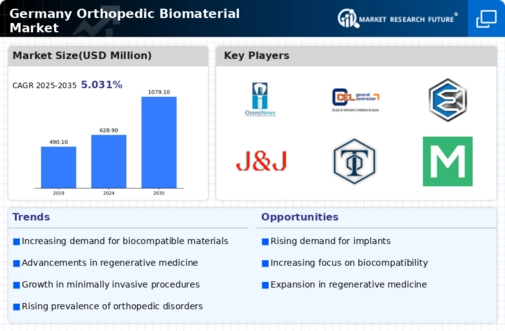The orthopedic biomaterial market in Germany is characterized by a dynamic competitive landscape, driven by innovation, technological advancements, and strategic partnerships. Key players such as DePuy Synthes (US), Stryker (US), and Aesculap (DE) are at the forefront, each adopting distinct strategies to enhance their market presence. DePuy Synthes (US) focuses on innovation through the development of advanced biomaterials that promote faster healing and improved patient outcomes. Stryker (US) emphasizes regional expansion and digital transformation, integrating cutting-edge technologies into their product offerings. Aesculap (DE), with its strong local presence, prioritizes partnerships with healthcare providers to tailor solutions that meet specific regional needs. Collectively, these strategies contribute to a competitive environment that is increasingly centered on technological differentiation and customer-centric solutions.
In terms of business tactics, companies are localizing manufacturing and optimizing supply chains to enhance efficiency and responsiveness to market demands. The competitive structure of the orthopedic biomaterial market appears moderately fragmented, with several key players exerting influence while also facing competition from emerging firms. This fragmentation allows for a diverse range of products and innovations, fostering a competitive atmosphere that encourages continuous improvement and adaptation.
In October 2025, Stryker (US) announced a strategic partnership with a leading German research institution to develop next-generation orthopedic implants utilizing bioactive materials. This collaboration is expected to enhance Stryker's product portfolio and position the company as a leader in innovative biomaterials. The strategic importance of this partnership lies in its potential to accelerate research and development, ultimately leading to improved patient outcomes and increased market share.
In September 2025, DePuy Synthes (US) launched a new line of biodegradable orthopedic implants designed to reduce the need for secondary surgeries. This initiative reflects the company's commitment to sustainability and innovation, addressing growing concerns regarding the environmental impact of traditional biomaterials. The introduction of biodegradable options may significantly influence market dynamics, as healthcare providers increasingly seek sustainable solutions.
In August 2025, Aesculap (DE) expanded its manufacturing capabilities in Germany, investing €10 million in a new facility dedicated to producing advanced orthopedic biomaterials. This expansion not only enhances Aesculap's production capacity but also underscores its commitment to meeting local demand and improving supply chain reliability. Such investments are likely to strengthen Aesculap's competitive position in the market.
As of November 2025, current trends in the orthopedic biomaterial market include a pronounced focus on digitalization, sustainability, and the integration of artificial intelligence (AI) in product development. Strategic alliances are increasingly shaping the competitive landscape, enabling companies to leverage complementary strengths and accelerate innovation. Looking ahead, competitive differentiation is expected to evolve, with a shift from price-based competition to a focus on technological advancements, innovative solutions, and reliable supply chains. This transition may redefine market dynamics, emphasizing the importance of quality and innovation over cost alone.





















Leave a Comment